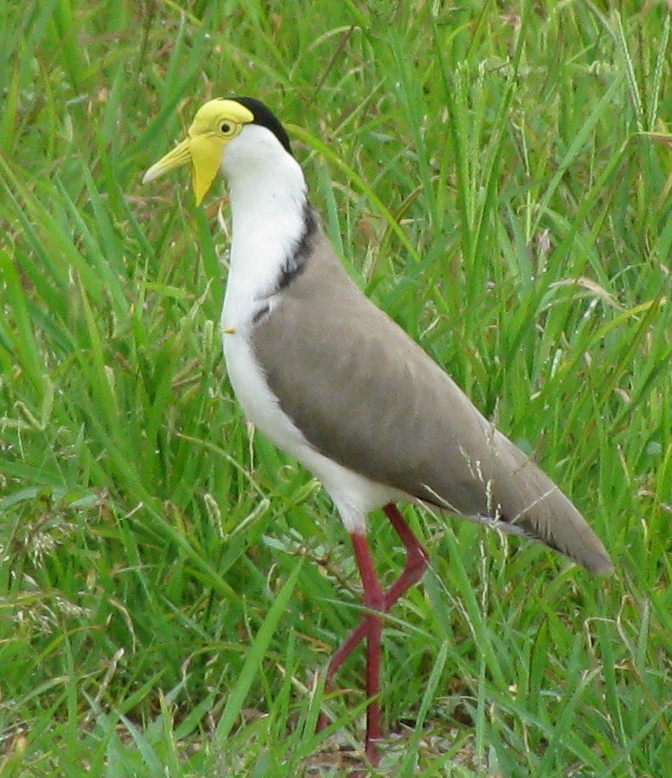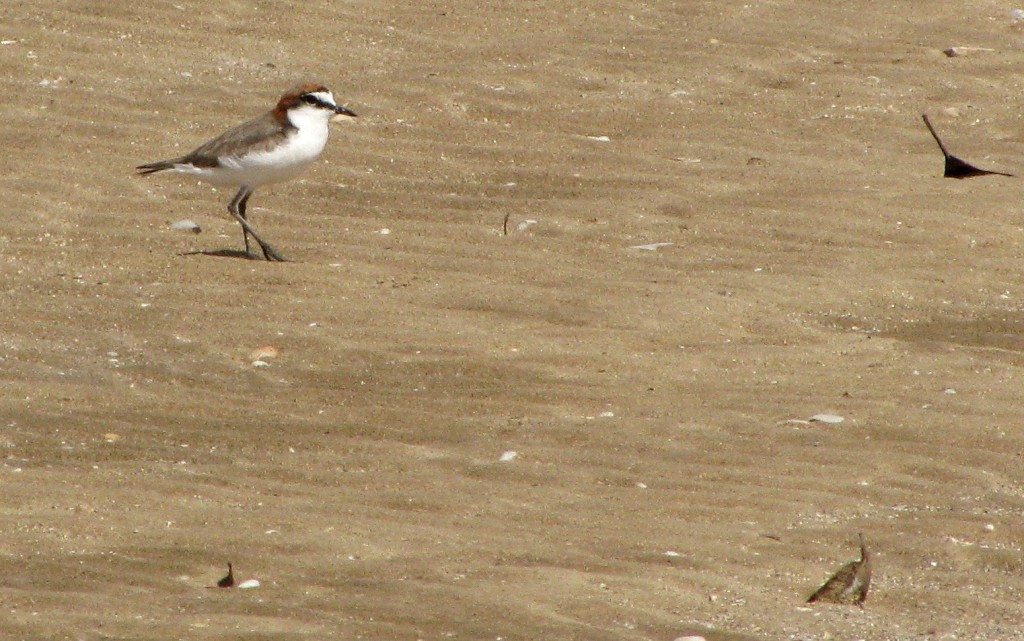As a birder, shorebirds are my nemesis. My discomfort with them is exceeded only by my even greater discomfort with seabirds. When it comes to the latter, I generally cringe or run in terror, although I’m getting braver with this country’s gulls and terns and quite enjoy the spectacular hunting dives of Australasian gannets. Perhaps hearkening back to a snippet of advice I once read, which stated that the best way to gain confidence is to do something you fear, I signed up in late August for a shorebird identification workshop to be held in Cungulla this morning and afternoon. Thus, after rising early to launder desert-dusted clothes and collect massive, dead palm leaves that had tumbled down into our yard in our absence, I loaded myself and my birding gear into Pat and Warren Charlton’s car and rode with them out to Cungulla, on Queenland’s east coast adjacent to Bowling Green Bay National Park south of Townsville.
During the classroom portion of the workshop, which was organized by George Baker and other TRBOC (Townsville Region Bird Observers Club) members in association with Birds Australia, I learned from George that 6 of Australia’s migratory shorebird species – the eastern curlew, curlew sandpiper, bar-tailed godwit, grey plover, and great and red knots – are suffering severely declining populations, and that a further 15 shorebird species are also presently showing evidence of declining numbers. These migratory shorebirds mate, lay eggs, and raise their young in the bounty of the brief Arctic summer in Siberia, China, and Alaska, and then fly south to Australia, New Zealand, and other South Pacific destinations during the Southern Hemisphere spring. Here, on this side of the world, they moult feathers and gorge themselves on insects, crustaceans, molluscs, and other invertebrates, replenishing muscle mass and loading on the fat needed to fuel their next migratory flight north.
During migrations, Australian migratory shorebirds utilize the East Asian-Australasian Flyway (EAAF), one of eight waterbird flyways that invisibly cover the earth’s surface like giant, curvy-edged portals leading from habitats in which these birds breed to those in which they replenish their energy stores.1 The EAAF is massive, spreading over 23 countries that incorporate almost half of the world’s human population.1 A total of 55 migratory shorebird species fly the EAAF, some of them making astonishing roundtrips of 25,000 kilometres each year.1 A female bar-tailed godwit fitted with a satellite-tracking device flew non-stop from Alaska to New Zealand in 8 days, covering the astounding distance of 11,700 kilometres without resting or feeding.2
In order to document perceived declines in shorebird populations, and thus to have the numbers to back requests for international government protection of priority staging (resting and feeding stopovers) and breeding areas, shorebird conservationists need to collect consistent, high-quality data. As my university-aged sons tell me, “Data is power.” This is the aim of Shorebirds 2020, a shorebird atlassing program which, as George described, hopes to document national and international population trends with the goal of understanding what is causing population declines, and therefore, to have a sound basis for making recommendations to governments for conservation.

Masked Lapwing (© Magi Nams)
The first step in counting shorebirds is, of course, to be able to identify them. Hence the Cungulla workshop, which I found extremely useful. Marleen Acton built up our confidence by quizzing us on common species possessing very obvious identifying characteristics – the masked lapwing, for example, with its yellow facial shield and wattles, black cap, grey back, and white throat and belly. (Note the pointed shoulder ‘spur’ on the adult lapwing in the photo.)
Then John Lowry led us through straightforward steps to assist us with the identification of more challenging species, particularly those in non-breeding plumage, which encompassed the whole lot of migratory shorebirds, although some may still bear remnants of breeding plumage on their arrival from the Far North. His key characteristics were: 1) size – small, medium, large; 2) bill – long, stubby, curved, straight, thin; 3) plumage – worn, fresh, moulting, breeding; 4) in flight – tail, legs, wingbars, axillaries (armpits); 5) call; 6) feeding behaviour – gregarious, solitary, probing, picking; and 7) habitat – rock, sand, mud, grass.
John broke down the shorebirds most likely to be seen in the Townsville area into 4 sub-groups: plovers (6), curlews, whimbrels, etc. (13) , sandpipers (10), and others (3), and then guided us through a series of practice identifications using photographs. He emphasized preparation, patience, and practice, as well as the fact that a birder doesn’t have to see everything to make an accurate identification. Only a few key field marks are necessary. As an example, he described the plover sub-group as small to medium-sized birds possessing short bills and large eyes, which pick food off the shoreline, around pools, or in grassy areas. One of these is the red-capped plover (a resident species), which is tiny and has a short beak, big eyes, and a rusty cap.
After a late lunch, we headed out onto the beach to have a go at identifying shorebirds in action, seen at the water’s edge through scopes. I shoved down my sudden ‘shorebird anxiety’ and peered through Pat Charlton’s scope, spotting what amazingly (to me) revealed themselves, with the aid of John’s clues, as bar-tailed godwits. A whimbrel and a grey plover still bearing remnants of breeding plumage strolled among the godwits, and I spotted a straight-beaked bird that turned out to be a great knot. A trio of Australian pied oystercatchers were dead giveaways, and an eastern curlew foraged on its own away from the band of godwits. Exhausted as I was from our Alice Springs trip (by noon, I was agreeing with Warren Charlton’s comment that I must be insane to do this workshop on the heels of arriving home from The Alice), I could see there was hope. My formerly bleary world of shorebird identification was shot through with shafts of light. Bring them on – just not today.

Red-capped Plover (© Magi Nams)
References:
1. Jo Oldland, Danny Rogers, Rob Clemens, Lainie Berry, Grainnie Macguire and Ken Gosbell. Shorebird Conservation in Australia. Birds Australia Conservation Statement, no. 14, 2009, pp. 2-3.
2. Phil Battley and Chris Hassell. Pacific Shorebird Migration Program – tracking shorebirds around the globe. p. 15 In: Jo Oldland, Danny Rogers, Rob Clemens, Lainie Berry, Grainnie Macguire and Ken Gosbell. Shorebird Conservation in Australia. Birds Australia Conservation Statement, no. 14, 2009, 20 p.


